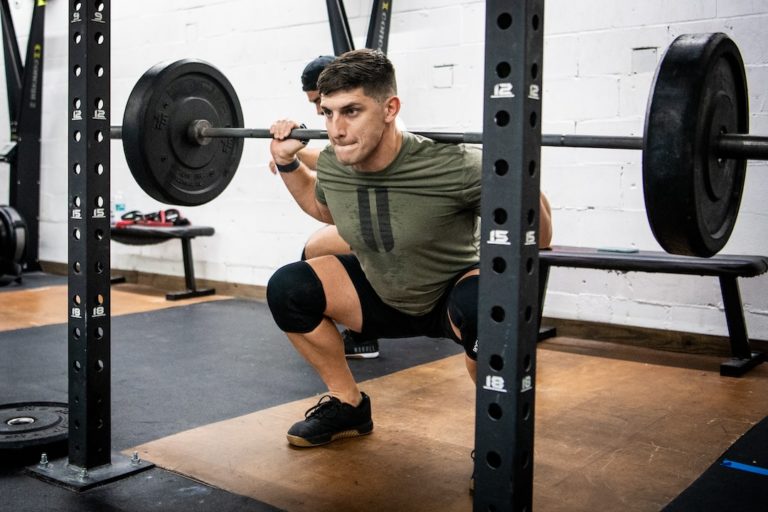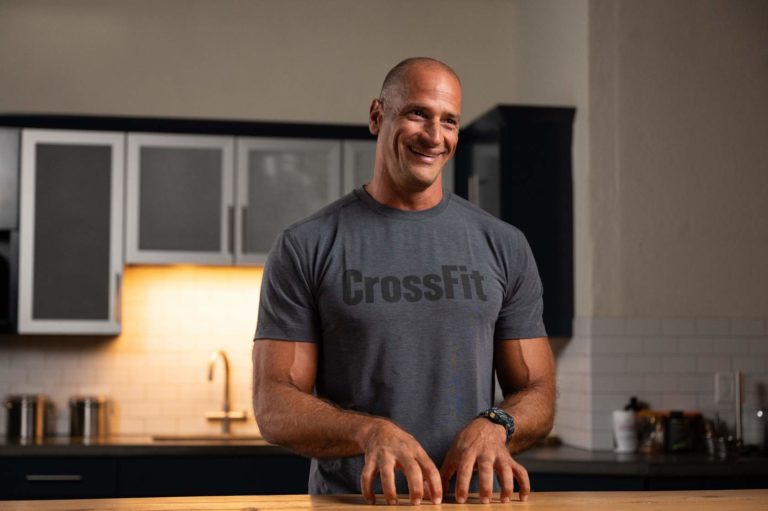Observing CrossFit Games athletes at a competition can be a valuable learning experience. We can glean insights into their warm-up, cool-down, and pacing techniques, which are generally effective and efficient. However, it’s important to recognize the significant differences between how we approach training for general fitness and health, and what we observe in high-level competitive athletes.
Rep Tempo
In competition, the name of the game is going as fast as you can. Athletes crank out the eccentric (“down” portion) and concentric (“up” portion) phases of each rep as fast as possible with no pause in between phases or reps. This is something we should all do at times, as long as we’re maintaining solid, safe technique. But this should not be how we operate all the time. Generally, when training for sport, general fitness, or a physically demanding job such as a soldier, firefighter, or police officer, the majority of our reps should have a smooth, somewhat controlled eccentric phase that transitions immediately into an explosive concentric phase with a brief pause to reset for the next rep to help us preserve technique.

For example, in the back squat, we lower the weight smoothly to the bottom position, and then we drive our feet into the ground to stand back up as fast as possible. With heavy weight, the stand won’t be fast, but it’s the effort to move the bar fast that counts. Then, we incorporate a short pause (this may be less than a second) to ensure we are in the proper position for the next rep. If you’re wondering how this style of rep will impact your time in a met-con, the answer is minimal. Your reps might be a touch slower but will probably be more efficient. In any case, most of the opportunity for improving our time in a workout comes from decreasing the number and length of rest breaks.
Emphasizing the benefits of slower-rep tempo and isometric holds, which are excellent training methods for building strength and refining technique, is crucial. Competitive athletes use these methods regularly to improve their fitness and skills. It’s important to note, however, that the rep speed in competition is only one method for executing a movement and should not constitute how we perform the majority of our reps when training for general fitness and health.
Range of Motion
CrossFit competitions do an excellent job of defining the required range of motion for every movement. We can use these requirements as guidelines in our training. However, we should not limit the range of motion to the competition standard if more range is available. For example, the competition standard for squatting movements requires the athlete to start in a standing position, with legs and hips fully extended, and descend to where the crease of the hips is below the top of the knees before standing back up. When competing, athletes will not descend any further than a bottom position where the crease of the hip is just below the top of the knees. That’s perfectly acceptable and is a fine range of motion to begin with. However, when training for general fitness, we want to work through this greater range of motion if we have the mobility and flexibility to travel 2 to 3 inches lower than the standard while preserving proper positions. This makes our reps slower, but the capacity, flexibility, and mobility built through the full range of motion are worth it.
There are also instances where athletes employ methods to ensure judges clearly see the range of motion requirement is met and the rep is counted. One example is thrusting the head forward on overhead movements such as thrusters, presses, or jerks to eliminate the impression the barbell is left out in front, which risks a no-rep. Another example is an exaggerated lean backward at the top of the deadlift to ensure the judge recognizes the athlete has fully extended the hips. We should not copy these tactics in our training. Such movement is only potentially beneficial in the context of a competition and can be harmful if performed regularly.
Technique
Competitive CrossFit athletes generally display excellent technique. Sound technique is more efficient and effective and allows for better performance overall. However, driven by their placement on the leaderboard, there are instances where these athletes sacrifice technique and see what they can get away with in hopes of getting a better time or lifting a heavier load.
Examples include bouncing off the chest in push-ups, reaching with the chin at the top of a pull-up, bouncing the weights in deadlifts, bouncing hard off of the trailing knee at the bottom of a lunge, or driving off the trailing leg in step-ups. Outside of competition, these technique deviations reduce the training effect we’re striving to achieve from the movement patterns we’ve selected, thereby compromising the quality of our results.
As we add load to a movement and approach or nudge past our previous records, it is not uncommon for our technique to break down. As we watch CrossFit athletes in competition fight for points in heavy events, we’ll see instances, even among the very best, where knees collapse in on heavy squats or backs round severely on heavy deadlifts. These athletes are compromising safety in hopes of securing the desired result. This is not what training should look like in the gym. When training for general fitness, maximal reps should look like submaximal reps, just at a slower bar speed. The load should be decreased as soon as minor faults appear that cannot be corrected. If major faults occur, there should be an understanding that the athlete went too heavy. These instances should be avoided or at least minimized in training.
Diet
Refueling with candy or soda is purely a competition tactic. CrossFit Games athletes use gummy bears or sugary drinks as tasty, easily ingested, and absorbed sources of carbohydrates to refuel after an event and prepare for the next intense workout. However, this strategy does not support our health and fitness. With no rush to replenish our glycogen stores, we can rely on whole, unprocessed foods like fruit, sweet potatoes, and raw honey to refuel.
Pushing Through Injury
It is not uncommon for athletes to push through pain and injury during a competition. Torn tendons, muscles or ligaments, or broken bones will not deter the most determined competitors. This perseverance is often seen as an admirable trait in a competitive setting. However, this is not a wise or recommended practice for the average affiliate athlete. With a long-term view of building fitness and health over a lifetime, we need to listen to our bodies and not let minor aches and tweaks become full-blown injuries that require us to take weeks or months off. Discomfort is different from pain. Training brings much discomfort but should not bring pain and damage to tissues and joints. It’s essential to know the difference and err on the side of caution by decreasing volume, working around a potential issue, getting treatment, and focusing on rest and recovery as needed. There is no reason to push ourselves until we break.
CrossFit Games athletes have much to share with us as long as we understand the context that defines why and how they do things. They are trying to win and secure prize money and sponsorships. Their focus is not on long-term health and fitness. Knowing this, we need to know which methods will help us pursue fitness and health, and which should primarily be reserved for high-level competition and rarely implemented by general fitness enthusiasts.
About the Author
 Stephane Rochet is a Senior Content Writer for CrossFit. He has worked as a Flowmaster on the CrossFit Seminar Staff and has over 15 years of experience as a collegiate/tactical strength and conditioning coach. He is a Certified CrossFit Trainer (CF-L3) and enjoys training athletes in his garage gym.
Stephane Rochet is a Senior Content Writer for CrossFit. He has worked as a Flowmaster on the CrossFit Seminar Staff and has over 15 years of experience as a collegiate/tactical strength and conditioning coach. He is a Certified CrossFit Trainer (CF-L3) and enjoys training athletes in his garage gym.